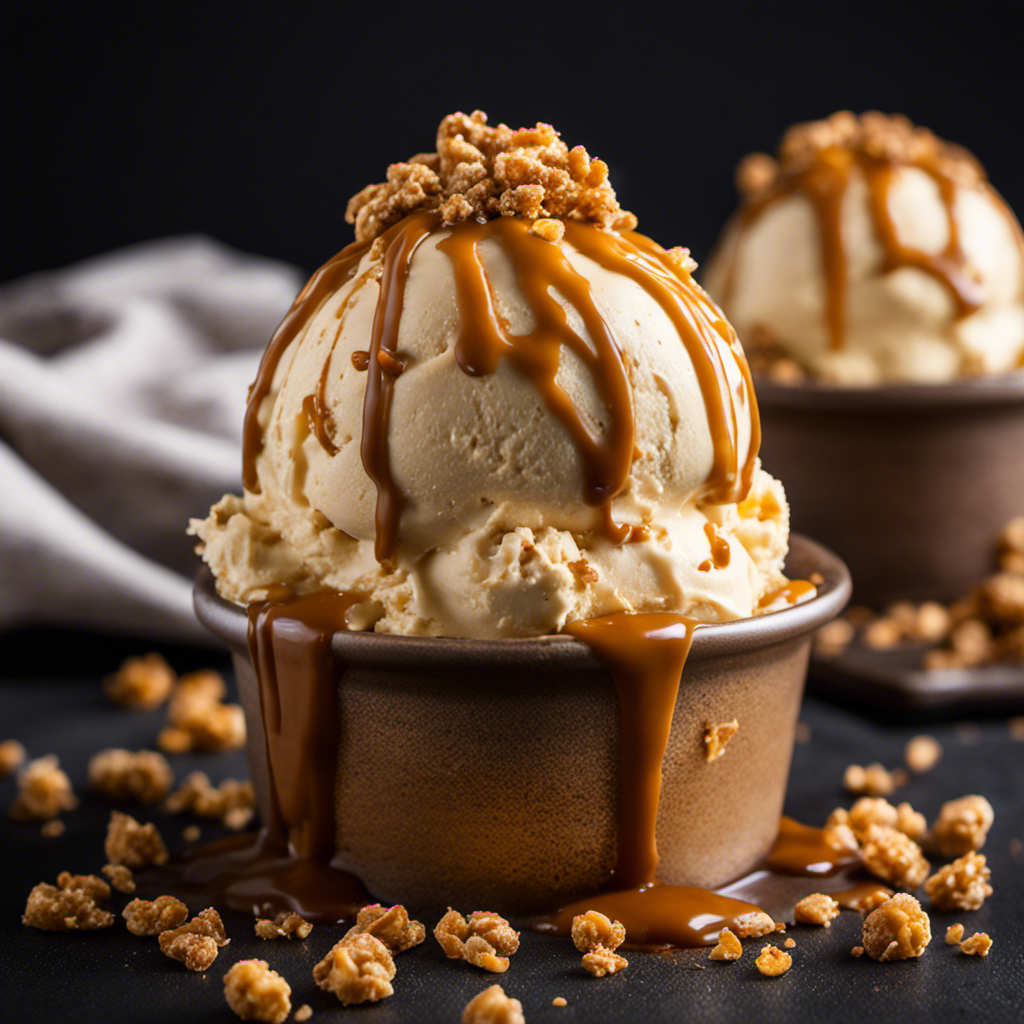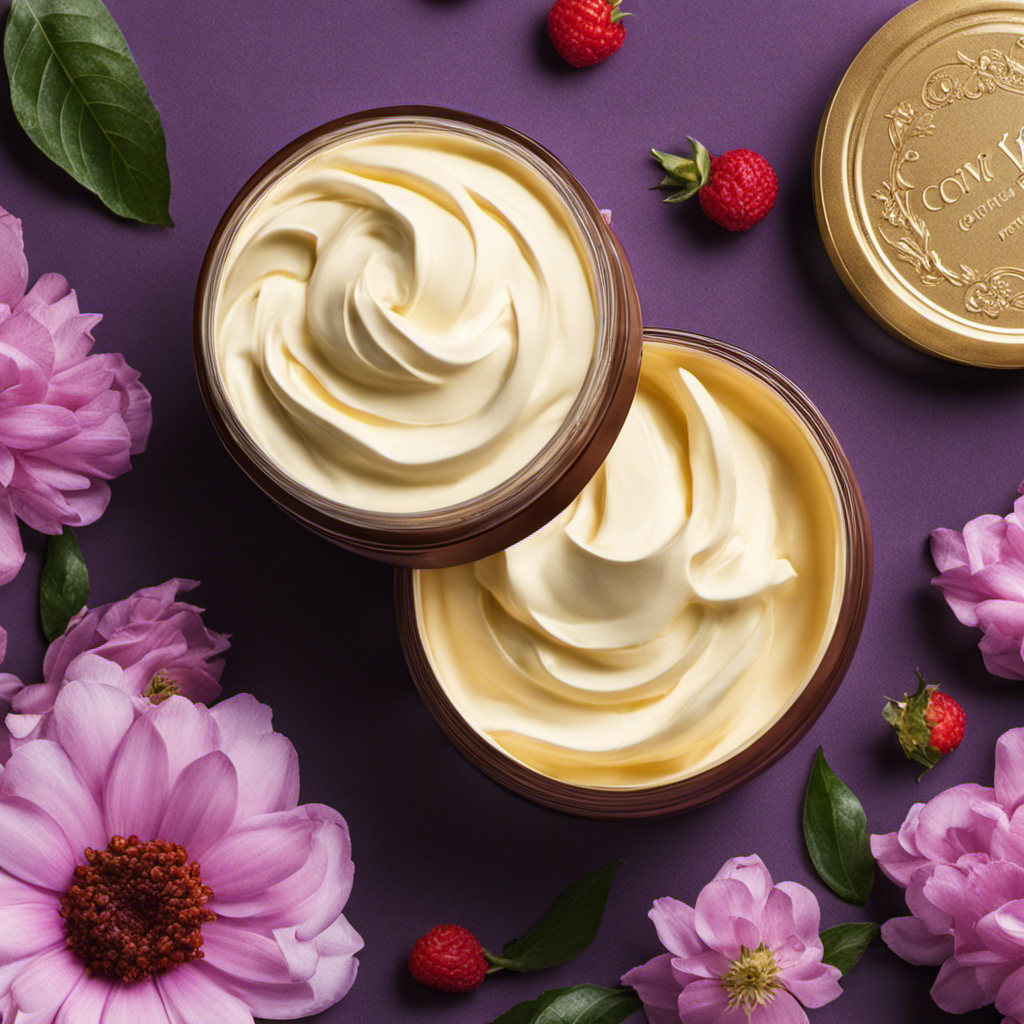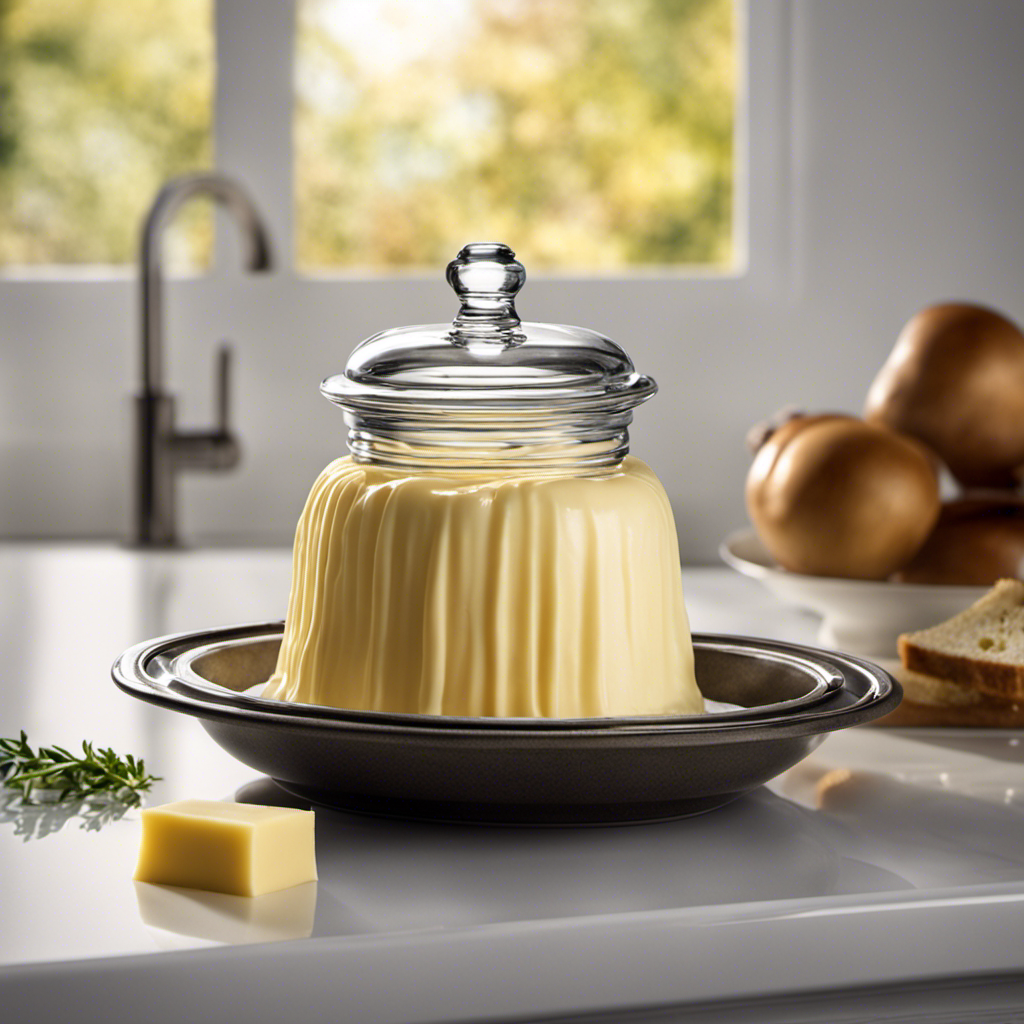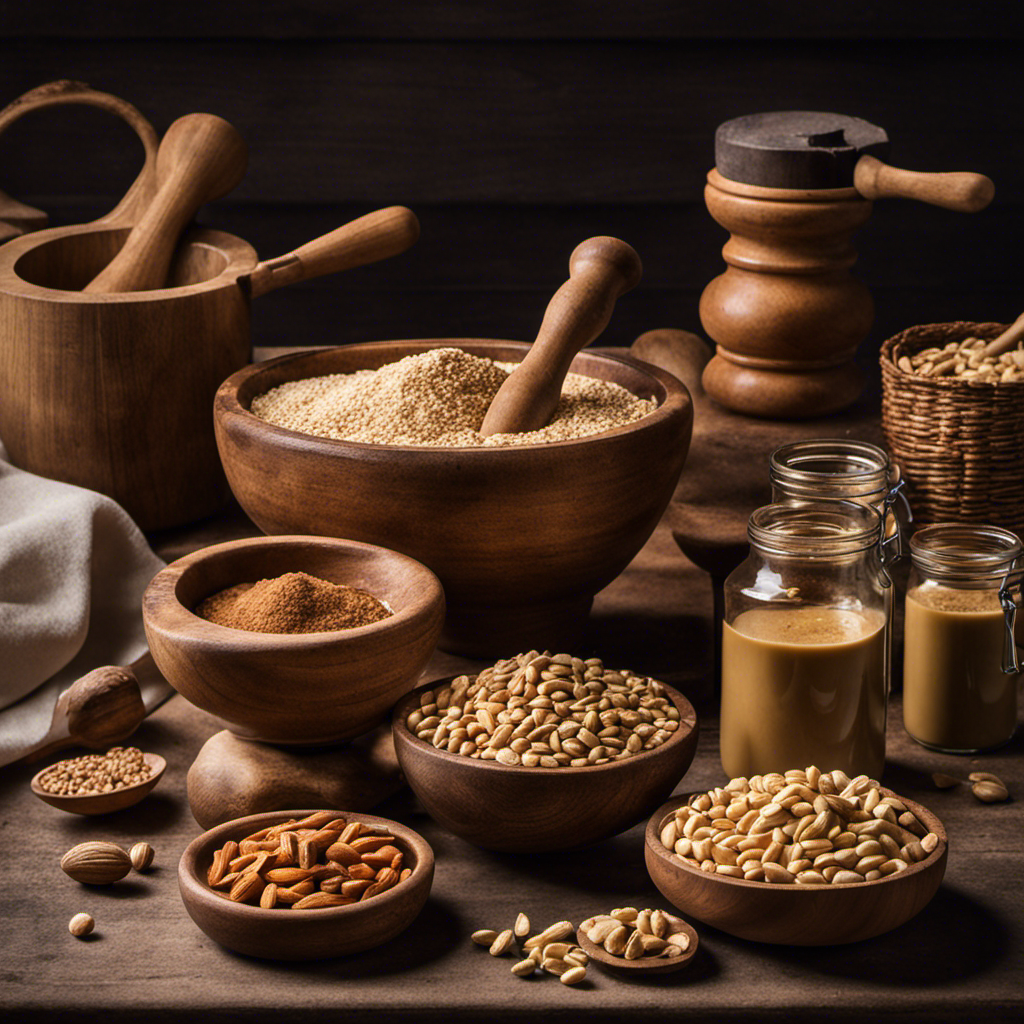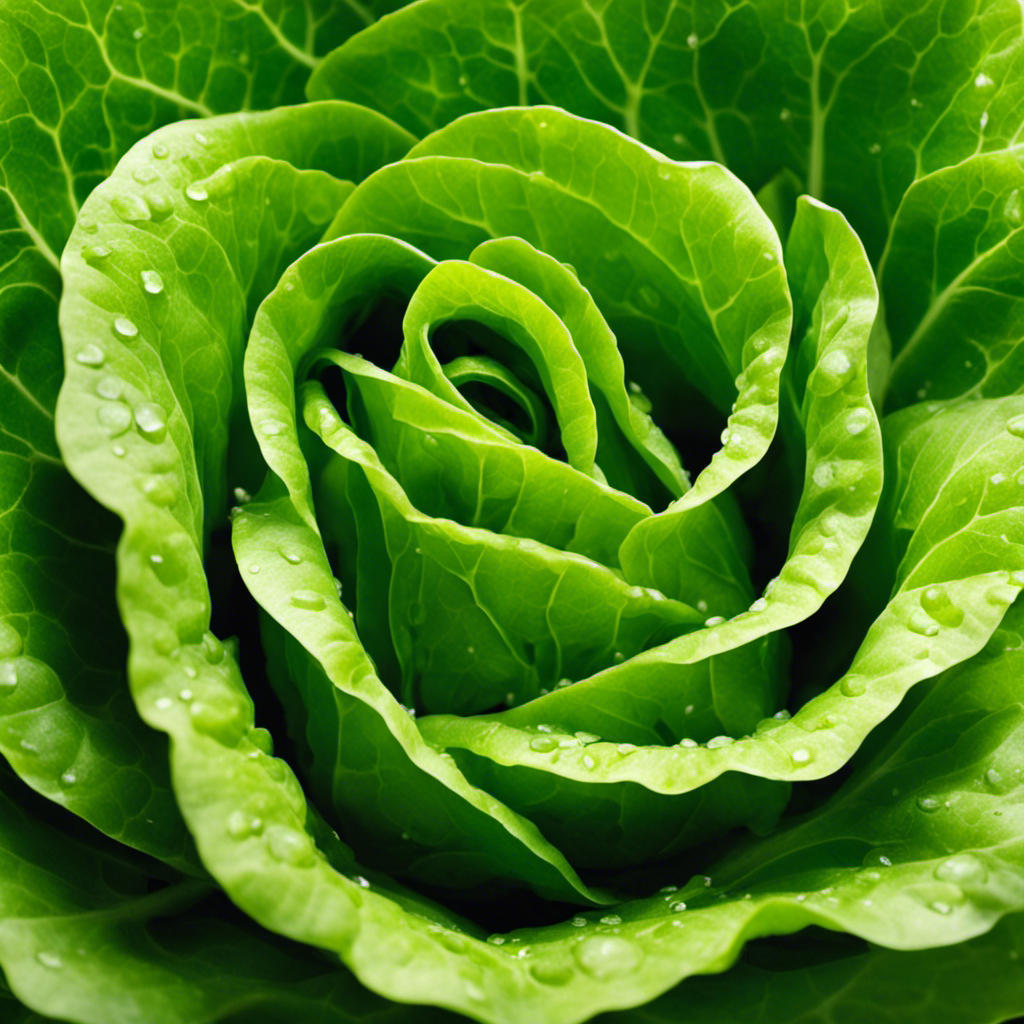I really love indulging in a scoop of butter crunch ice cream on a hot summer day. The creaminess, the decadent caramel flavor, and the satisfying crunch of the buttery toffee bits come together to create a perfect blend of flavors with every bite.
But have you ever wondered what exactly butter crunch ice cream is? In this article, we will explore its origins, the ingredients used, the process of making it, and even some popular brands that offer this delectable treat.
So, get ready to dive into the world of butter crunch ice cream!
Key Takeaways
- Butter crunch ice cream originated in the early 20th century in the United States and quickly gained popularity for its rich and creamy texture.
- The flavor variations of butter crunch ice cream include chocolate chips, caramel swirls, and crunchy nuts, offering options for different preferences.
- Baskin-Robbins and Ben & Jerry’s are two popular brands known for their decadent butter crunch ice cream, with each offering their unique twist with added ingredients like toffee bits, caramel swirls, and chocolate chunks.
- While butter crunch ice cream is delicious, it is high in calories, fat, and sugar, so it should be enjoyed in moderation as an occasional indulgence.
The Origins of Butter Crunch Ice Cream
You might be interested to know that the origins of butter crunch ice cream can be traced back to the early 20th century. It was first created in the United States and quickly gained popularity for its rich and creamy texture, combined with the delightful crunch of buttery toffee.
The flavor variations of butter crunch ice cream are endless, with some popular options including adding chocolate chips, caramel swirls, or even pieces of crunchy nuts.
As for pairing suggestions, butter crunch ice cream pairs well with warm desserts like apple pie or brownies, enhancing the flavors and providing a refreshing contrast of temperatures. It is also delicious on its own, allowing you to savor the buttery goodness with each creamy spoonful.
Ingredients Used in Butter Crunch Ice Cream
When making this delightful frozen treat, it’s essential to include a combination of sweet and crunchy elements. Butter crunch ice cream flavors come in a variety of options, offering a range of tastes to satisfy any palate. The different textures of butter crunch ice cream add to its appeal, providing a delightful contrast in every bite.
Here are some popular flavors and textures you can find in butter crunch ice cream:
- Classic vanilla with buttery toffee bits
- Rich chocolate with crunchy caramelized nuts
- Creamy caramel with a sprinkle of buttery crumble
- Indulgent peanut butter with crispy chocolate chunks
- Decadent coffee with a delightful praline swirl
These flavor combinations and textural contrasts create a truly enjoyable ice cream experience.
Now, let’s delve into the process of making butter crunch ice cream.
The Process of Making Butter Crunch Ice Cream
To start making this delectable frozen treat, grab a pot and combine the milk, sugar, and vanilla extract. Heat the mixture over medium heat until it reaches a simmer, stirring occasionally to dissolve the sugar.
While this is happening, we can dive into the science behind freezing ice cream. Freezing ice cream involves a process called crystallization. When the mixture is frozen, ice crystals form and give the ice cream its texture.
The role of butter in ice cream making is to add richness and creaminess. Butter contains milk fat, which helps stabilize the ice cream and prevent it from becoming too icy.
Once the milk mixture has simmered, pour it into a bowl and let it cool. Then, add in the butter and stir until melted and well-incorporated. This will give our butter crunch ice cream its smooth, buttery flavor.
Different Variations of Butter Crunch Ice Cream
When it comes to toppings for butter crunch ice cream, there are endless possibilities to explore. From classic options like hot fudge and caramel sauce to more adventurous choices like crushed cookies or fresh fruit, the choice is yours to make.
Another aspect to consider is whether to go for homemade or store-bought butter crunch ice cream. While homemade versions allow for more control over the ingredients and flavors, store-bought options offer convenience and a wide range of brands to choose from.
Lastly, if you’re feeling adventurous, you can experiment with unique flavor combinations for your butter crunch ice cream, such as adding a hint of espresso or mixing in chunks of your favorite candy. The possibilities are truly endless when it comes to creating a personalized and delicious butter crunch ice cream experience.
Toppings for Butter Crunch
For your butter crunch ice cream, you can add a variety of delicious toppings. These toppings will enhance the flavor and texture of your ice cream, making it even more indulgent and satisfying. Here are some of the best ice cream toppings to consider:
- Hot fudge sauce: Drizzle some warm, rich chocolate sauce over your butter crunch ice cream for a heavenly combination of flavors.
- Caramel sauce: The sweet and buttery taste of caramel complements the butter crunch perfectly, creating a delightful blend of flavors.
- Chopped nuts: Whether it’s toasted almonds, pecans, or walnuts, adding some crunchy nuts to your ice cream adds a wonderful texture and nutty flavor.
- Whipped cream: A dollop of fluffy whipped cream on top of your butter crunch ice cream adds a light and creamy element to each bite.
- Sprinkles: Colorful and fun, sprinkles add a touch of whimsy to your ice cream, making it even more enjoyable.
With these delicious toppings, your butter crunch ice cream will be taken to the next level of deliciousness.
Now let’s explore the difference between homemade and store-bought butter crunch ice cream.
Homemade Vs. Store-Bought
There’s a noticeable difference in taste between homemade and store-bought versions of butter crunch ice cream.
When it comes to homemade advantages, the first thing that comes to mind is the freshness. Making your own butter crunch ice cream allows you to control the quality of ingredients and customize the flavor to your liking. You can use real butter, high-quality chocolate, and fresh cream, resulting in a rich and creamy texture. Additionally, homemade ice cream often has a more intense and authentic butter crunch flavor, as you can add more or less to suit your taste.
On the other hand, the store-bought variety offers convenience. It saves time and effort, especially for those who don’t have the necessary equipment or prefer ready-made options. Although it may lack the distinctive homemade taste, store-bought butter crunch ice cream can still be a delicious treat for those seeking a quick fix.
Unique Flavor Combinations
You can explore a variety of unique flavor combinations to create a one-of-a-kind ice cream experience. Experimenting with different flavors can be a fun and delicious way to create your own signature ice cream. Here are some ideas to get you started:
-
Raspberry and dark chocolate: The tartness of the raspberries pairs perfectly with the rich, bittersweet chocolate.
-
Salted caramel and pretzel: The sweet and salty combination is a classic favorite that never disappoints.
-
Lavender and honey: This floral and sweet combination is a unique and refreshing option.
-
Matcha and coconut: The earthy taste of matcha blends well with the creamy, tropical flavor of coconut.
-
Peanut butter and banana: The creamy, nutty taste of peanut butter complements the natural sweetness of bananas.
To find the perfect flavor profiles, I recommend conducting taste testing sessions with small batches of ice cream. This way, you can adjust the ratios of ingredients until you achieve the desired taste.
Have fun exploring and creating your own unique ice cream flavors!
Popular Brands That Offer Butter Crunch Ice Cream
Baskin-Robbins and Ben & Jerry’s are two popular brands that offer butter crunch ice cream.
Both brands have their own unique take on this classic flavor, creating a delightful treat for ice cream enthusiasts.
Baskin-Robbins offers a smooth and creamy butter crunch ice cream with crunchy toffee bits mixed in, providing a perfect balance of textures.
On the other hand, Ben & Jerry’s takes a more indulgent approach by incorporating swirls of rich caramel and chocolate chunks into their butter crunch ice cream.
The combination of these flavors creates a decadent and irresistible treat.
While both brands offer delicious options, the best flavor of butter crunch ice cream ultimately depends on personal preference.
Whether you prefer a simpler, smoother option or a more indulgent and complex flavor profile, Baskin-Robbins and Ben & Jerry’s have you covered.
Pairing Suggestions for Butter Crunch Ice Cream
Indulge in the perfect pairing for your butter crunch ice cream with a slice of warm apple pie. The creamy, buttery flavor of the ice cream complements the sweet and tart taste of the apple pie, creating a delightful combination that will satisfy your taste buds.
But don’t stop there! Butter crunch ice cream is versatile and can be paired with a variety of desserts for a unique and delicious experience. Here are some alternative desserts that pair well with butter crunch ice cream:
-
Salted caramel brownies: The rich caramel flavor and the crunchy texture of the brownies complement the creamy butter crunch ice cream.
-
Chocolate chip cookies: The classic combination of chocolate and butter crunch ice cream is a crowd-pleaser.
-
Pecan pie: The nutty and caramel flavors of the pecan pie are enhanced by the buttery taste of the ice cream.
-
Banana bread: The moist and flavorful banana bread pairs perfectly with the creamy and crunchy ice cream.
-
Strawberry shortcake: The sweetness of the strawberries and the lightness of the cake are balanced by the rich butter crunch ice cream.
The Health Benefits of Butter Crunch Ice Cream
After exploring different pairing suggestions for butter crunch ice cream, let’s now delve into the health benefits of this delectable treat. Butter crunch ice cream is known for its rich and creamy taste, with the perfect balance of sweet and buttery flavors. However, when it comes to its nutritional value, it’s important to approach it with moderation.
Here is a table that highlights the nutritional content of a typical serving size of butter crunch ice cream:
| Nutrient | Amount per serving |
|---|---|
| Calories | 250 |
| Fat | 15g |
| Carbohydrates | 25g |
| Protein | 4g |
| Sugar | 20g |
While butter crunch ice cream does contain some essential nutrients like protein, it is also high in calories, fat, and sugar. Enjoying it as an occasional indulgence can be a delightful treat, but it’s important to balance it with a healthy and varied diet.
Frequently Asked Questions
How Many Calories Are in a Serving of Butter Crunch Ice Cream?
There are approximately 250 calories in a serving of butter crunch ice cream. For those looking for vegan options, there are dairy-free versions available made with plant-based ingredients.
Can Butter Crunch Ice Cream Be Made Without Dairy?
Yes, butter crunch ice cream can be made without dairy. There are vegan alternatives available that use plant-based ingredients. These options not only cater to dietary restrictions but also offer health benefits.
Is Butter Crunch Ice Cream Gluten-Free?
Butter crunch ice cream may not be gluten-free, making it unsafe for people with celiac disease. It is important to check the ingredients and labels to ensure there is no gluten present. Additionally, butter crunch and toffee crunch ice cream may have slight differences in flavor and texture.
What Is the Shelf Life of Butter Crunch Ice Cream?
The shelf life of butter crunch ice cream depends on the ingredients used. It typically lasts for several months if stored properly in a freezer. It’s important to check the packaging for specific recommendations.
Can I Make Butter Crunch Ice Cream at Home Without an Ice Cream Maker?
Sure, you can make homemade butter crunch ice cream without an ice cream maker. One popular recipe involves mixing cream, sugar, vanilla, and crushed butter crunch candy bars, then freezing the mixture.
Conclusion
In conclusion, butter crunch ice cream is a delectable treat that combines the creamy richness of traditional ice cream with the irresistible crunch of buttery toffee.
Its origins can be traced back to the early 20th century, and it has since become a popular flavor among ice cream enthusiasts.
With a variety of variations and brands available, there is something for everyone’s taste buds.
So next time you’re in the mood for a sweet indulgence, treat yourself to a scoop of butter crunch ice cream and experience the delightful combination of flavors and textures, like a symphony playing in your mouth.
